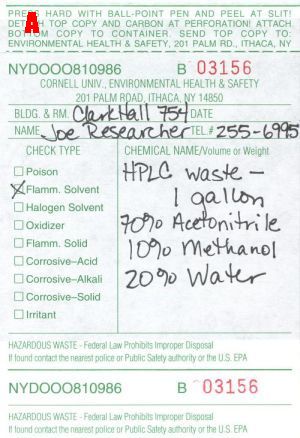| Page 7 |

|
|
1 - Hazardous Waste Management
2 - Page 2 3 - Page 3 4 - Page 4 5 - Page 5 6 - Page 6 7 - Page 7 8 - Page 8 9 - Page 9 |

 HOME
HOMEHazardous waste can never be poured down the drain or placed in regular trash, unless specified by your supervisor or the safety officer. And remember that "the solution to pollution is NOT dilution". If you are not sure of how to dispose of a chemical, ask your supervisor.
Satellite Accumulation AreasThese are areas where hazardous wastes that are generated as part of the laboratory activity are collected and properly stored until they are transferred to the main accumulation area.
Each faculty member assigned a laboratory is responsible for the management of the designated Satellite Accumulation Areas for the collection of hazardous wastes generated in his/her laboratory. The following requirements apply to the operation and management of a Satellite Accumulation Area:
- Signage - each area must have a sign designating it as the Satellite Accumulation Area.
- Weekly Inspection - each area must be inspected weekly, the items to be inspected are listed on the inspection sheet. The Principle Investigator in charge of the laboratory is responsible for ensuring this inspection is done weekly.
- Segregation and Containment - the wastes must be separated by chemical compatibility groups, each group of containers must be provided with appropriate secondary containment. Containment trays and tubs are available from OEH&S. Additional information on compatibility is provided below.
- Storage - only one container per waste stream (type of waste) is allowed for each Satellite Accumulation Area, i.e.: one container for halogenated solvents, one container for non-halogenated solvents.
- Labeling - all waste containers must be labeled with the words "Hazardous Waste" the chemical constituents and the hazard classification (Ignitable, Corrosive, Reactive or Toxic). Containers in Satellite Accumulation Areas shall not be dated until they are full. Waste containers may be kept in a Satellite Accumulation Area until they are full. When full the container must have that date indicated on the label and be removed from the Satellite Accumulation Area within three days.
- Closure - all containers must be closed at all times except when actually adding waste. A funnel sitting in the mouth of the bottle is not the same as "closed container"
Labeling
 |
Each container must be labeled with the words "Hazardous Waste"
Use the EH&S label pictured to the left on every bottle designated for hazardous waste storage.
Paste the bottem part of the label onto the bottle as it is being filled. Once full, paste the rest of the label on the bottle.
Containers in Satellite Accumulation Areas shall not be dated until they are full.
 |
Example of properly completed label
Example of properly completed label
Full names of the chemical components are listed
Relative amounts are listed
Correct chemical type is checked
All the contact information is complete
Date field to be completed when it is ready to be moved out of the Satellite Accumulation Area and into the storage cabinet in the shipping/receiving room
Full Container of hazardous waste are taken from laboratories to the hazardous waste storage cabinet in room G-26
Chemical Compatibility
The following chart is provided as a guide to segregating hazardous waste containers, it is not to be used for mixing chemicals. Containers of incompatible wastes must be stored in separate containment areas.
Many hazardous wastes, when mixed with other waste or material, can produce effects which are harmful to human health and the environment, such as (1) heat or pressure, (2) fire or explosion, (3) violent reaction, (4) toxic dusts; mists, fumes, or gases, or (5) flammable fumes or gases.
Below are examples of potentially incompatible wastes, waste components, and materials, along with the harmful consequences which might result from mixing material in one group with material in another group. The list is intended only as a guide to indicate the need for special precautions when managing these potentially incompatible waste materials or components.
This list is not intended to be exhaustive. A laboratory director shall, as regulations require, adequately analyze his or her wastes so that he can prevent creating uncontrolled substances or reactions of the type listed below, whether they are listed below or not.
In the lists below, the mixing of a Group A material with a Group B material might have the potential consequences as noted.
| << Previous 1 2 3 4 5 6 [7] 8 9 Next >> |

